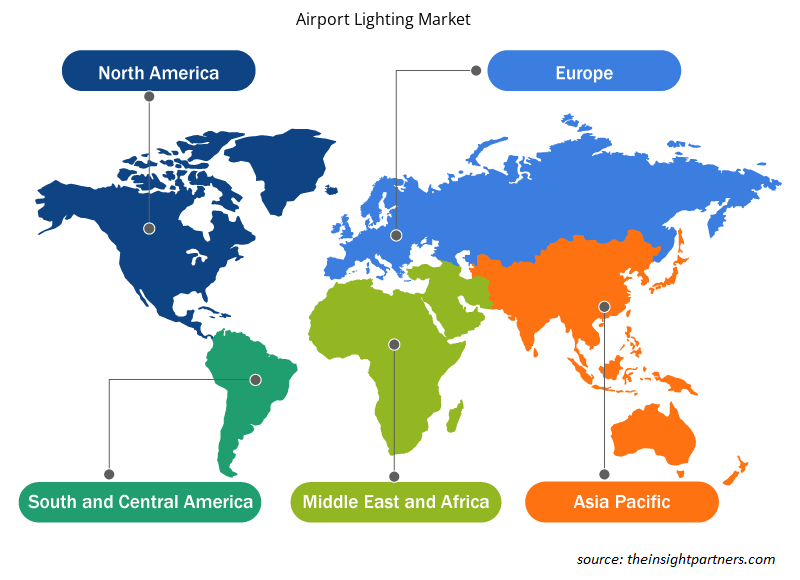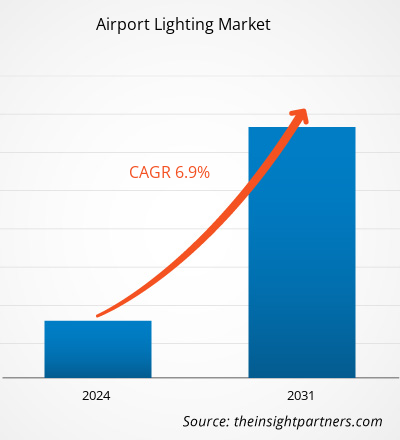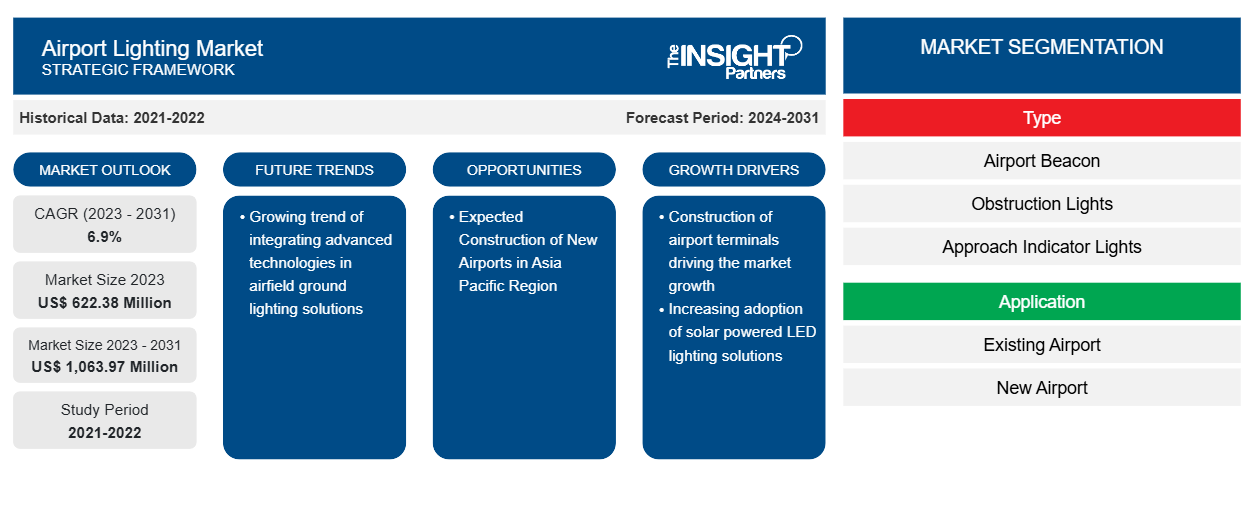Der Markt für Flughafenbeleuchtung wird voraussichtlich von 622,38 Millionen US-Dollar im Jahr 2023 auf 1.063,97 Millionen US-Dollar im Jahr 2031 anwachsen. Der Markt wird zwischen 2023 und 2031 voraussichtlich eine durchschnittliche jährliche Wachstumsrate (CAGR) von 6,9 % verzeichnen. Der wachsende Trend zur Integration fortschrittlicher Technologien in Lösungen zur Bodenbeleuchtung von Flugplätzen dürfte ein wichtiger Trend auf dem Markt bleiben.
Marktanalyse für Flughafenbeleuchtung
Die Hersteller von Flughafenbeleuchtung beziehen verschiedene Komponenten von unterschiedlichen Komponentenherstellern und integrieren diese in ihre Produkte. Aufgrund der gestiegenen Nachfrage nach dieser Technologie herrscht unter den Herstellern von Flughafenbeleuchtung immer ein starker Wettbewerb. Außerdem werden die Spezifikationen dieser Beleuchtungslösungen durch Zertifizierungen definiert, nämlich FAA und ICAO. Der Hersteller oder Lieferant muss mit seinen Mitbewerbern auf der Grundlage von Preis, Lieferzeit und Kundendienst konkurrieren, was den Wettbewerb auf dem Markt infolgedessen verstärkt. Die Produkthersteller verkaufen ihre Produkte entweder über Direktvertriebskanäle oder über Offline-Händler. Die Flughafenbeleuchtung wird auch über Online-Kanäle bezogen, was den Wettbewerb zwischen den Akteuren weiter verschärft. Zu den wichtigsten Herstellern von Flughafenbeleuchtung gehören unter anderem ADB Safegate, Astronics Corporation, Carmanah Technologies, Honeywell International Inc., OSRAM GmbH und OCEM Airfield Technology. Der Markt für Flughafenbeleuchtung ist fragmentiert, und mehrere Akteure sind auf dem Markt tätig und tragen so Jahr für Jahr erheblich zum Umsatz bei.
Marktübersicht für Flughafenbeleuchtung
Die Lieferkettenanalyse auf dem Markt für Flughafenbeleuchtung analysiert den Beitrag der Akteure, die im Ökosystem tätig sind, wie z. B. Hersteller von Rohmaterialien oder Komponenten, OEM, Systemintegratoren, Vertriebskanäle und Endnutzer. Die Flughafenbeleuchtung besteht aus mehreren Komponenten, darunter LED-Chipkabel , Kabelsätze, Lampenfassungen, Fassungsadapter, Lampenaufhängungen und Metallkomponenten. Die Komponentenhersteller arbeiten synchron mit den Erstausrüstern, die ihre Produkte über mehrere Vertriebskanäle direkt an den Endnutzer liefern oder sie an den Systemintegrator liefern, der das erforderliche System entwirft und es dann am Flughafen integriert. Um den sich schnell ändernden Anforderungen an Flughafenbeleuchtungslösungen gerecht zu werden, investieren diese Komponentenhersteller erhebliche Beträge in die Gestaltung und Entwicklung robuster Getriebe. Aufgrund der Bedeutung jeder Komponente legen die Endnutzer und Zertifizierungsbehörden großen Wert auf die Angabe der Maße. Zu den weltweiten Herstellern von Flughafenbeleuchtungskomponenten gehören unter anderem Cree Inc., AVS Lighting Components und Inlico. Verschiedene andere Komponentenhersteller sind ebenfalls auf dem Markt tätig und unterstützen die Hersteller von Flughafenbeleuchtung dabei, den wachsenden Bedarf der jeweiligen Kundschaft an solchen Beleuchtungslösungen zu decken.
Passen Sie diesen Bericht Ihren Anforderungen an
Sie erhalten kostenlos individuelle Anpassungen an jedem Bericht, einschließlich Teilen dieses Berichts oder einer Analyse auf Länderebene, eines Excel-Datenpakets sowie tolle Angebote und Rabatte für Start-ups und Universitäten.
-
Holen Sie sich die wichtigsten Markttrends aus diesem Bericht.Dieses KOSTENLOSE Beispiel umfasst eine Datenanalyse von Markttrends bis hin zu Schätzungen und Prognosen.
Treiber und Chancen auf dem Flughafenbeleuchtungsmarkt
Bau von Flughafenterminals treibt das Marktwachstum an
Mehrere Bauprojekte für Flughafenterminals wurden abgeschlossen und im Jahr 2023 angekündigt, was den Markt für die Installation von Flughafenbeleuchtungen angetrieben hat. Darüber hinaus dürften die bevorstehenden Pläne für den Bau neuer Flughafenterminals den Markt in den kommenden Jahren antreiben. Zum Beispiel:
- Im Januar 2023 nahm der Newark Liberty International Airport (EWR) den Passagierbetrieb in seinem neuen Terminal A auf.
- Im Februar 2023 gab der Kansas City International Airport (USA) die Eröffnung seines neuen Einzelterminals bekannt, das die drei zuvor in Betrieb befindlichen Terminals ersetzt.
- Im März 2023 kündigte der Flughafen Auckland (NZL) an, 3,9 Milliarden US-Dollar in sein Terminalintegrationsprogramm zu investieren.
- Im April 2023 gab der Chennai International Airport (IND) die Eröffnung seines neuen Terminals bekannt, das sich über 136.295 Quadratmeter erstreckt und die Kapazität des Flughafens um 23 auf 30 Millionen Passagiere pro Jahr erhöht.
Solche Faktoren haben die Nachfrage nach Flughafenbeleuchtung für Terminalanwendungen erhöht.
Voraussichtlicher Bau neuer Flughäfen im Asien-Pazifik-Raum
Der Anstieg neuer Bauprojekte ist einer der Hauptfaktoren, der Marktanbietern in den kommenden Jahren wahrscheinlich neue Chancen bieten wird. So kündigte die Zivilluftfahrtbehörde Chinas (CAAC) im Jahr 2018 an, bis Ende 2035 216 neue Flughäfen im Land zu bauen. Auch die indische Regierung hat Investitionen in Höhe von 12 Milliarden US-Dollar für den Bau von 72 neuen Flughäfen bis Ende 2025 angekündigt. Solche Faktoren werden wahrscheinlich eine neue Nachfrage nach Flughafenbeleuchtungslösungen im gesamten asiatisch-pazifischen Raum erzeugen und Marktanbietern in den kommenden Jahren neue Chancen bieten.markt vendors in the coming years. For instance, in 2018, the Civil Aviation Administration of China (CAAC) announced to construct 216 new airport in the country by the end of 2035. Similarly, the Indian government has also announced the investments worth US$ 12 billion for the construction of 72 new airports by the end of 2025. Such factors are likely to generate new demand for airport lighting solutions across the Asia Pacific region and will provide new opportunities for market vendors in the coming years.
Segmentierungsanalyse des Marktberichts zur Flughafenbeleuchtung
Schlüsselsegmente, die zur Ableitung der Marktanalyse für Flughafenbeleuchtung beigetragen haben, sind Typ und Anwendung.
- Nach Typ ist der Markt für Flughafenbeleuchtung in Flughafenfeuer , Hindernisfeuer, Anfluganzeiger, Start- und Landebahnmittellinienfeuer, Rollbahnfeuer und andere unterteilt. Das Segment der Anfluganzeiger hatte im Jahr 2023 einen größeren Marktanteil.
- Basierend auf der Anwendung ist der Markt für Flughafenbeleuchtung in bestehende und neue Flughäfen unterteilt. Das Segment der bestehenden Flughäfen hatte im Jahr 2023 einen größeren Marktanteil.
Marktanteilsanalyse für Flughafenbeleuchtung nach Geografie
Der geografische Umfang des Marktberichts zur Flughafenbeleuchtung ist hauptsächlich in fünf Regionen unterteilt: Nordamerika, Europa, Asien-Pazifik, Naher Osten und Afrika sowie Südamerika.
Der asiatisch-pazifische Raum dominierte den Markt im Jahr 2023, gefolgt von Europa und Nordamerika. Darüber hinaus wird der asiatisch-pazifische Raum in den kommenden Jahren voraussichtlich die höchste durchschnittliche jährliche Wachstumsrate verzeichnen. Dies ist hauptsächlich auf die große Zahl neuer Flughafenbauprojekte in den Ländern der APAC-Region in den kommenden Jahren zurückzuführen. So haben Indien und China bereits angekündigt, bis Ende 2035 mehr als 285 Flughäfen zu bauen, was die Nachfrage nach Flughafenbeleuchtungslösungen in der Region voraussichtlich weiter ankurbeln wird.
Regionale Einblicke in den Markt für Flughafenbeleuchtung
Die regionalen Trends und Faktoren, die den Flughafenbeleuchtungsmarkt während des Prognosezeitraums beeinflussen, wurden von den Analysten von Insight Partners ausführlich erläutert. In diesem Abschnitt werden auch die Marktsegmente und die Geografie des Flughafenbeleuchtungsmarkts in Nordamerika, Europa, im asiatisch-pazifischen Raum, im Nahen Osten und Afrika sowie in Süd- und Mittelamerika erörtert.

- Erhalten Sie regionale Daten zum Flughafenbeleuchtungsmarkt
Umfang des Marktberichts zur Flughafenbeleuchtung
| Berichtsattribut | Details |
|---|---|
| Marktgröße im Jahr 2023 | 622,38 Millionen US-Dollar |
| Marktgröße bis 2031 | 1.063,97 Millionen US-Dollar |
| Globale CAGR (2023 - 2031) | 6,9 % |
| Historische Daten | 2021-2022 |
| Prognosezeitraum | 2024–2031 |
| Abgedeckte Segmente |
Nach Typ
|
| Abgedeckte Regionen und Länder |
Nordamerika
|
| Marktführer und wichtige Unternehmensprofile |
|
Marktteilnehmerdichte: Der Einfluss auf die Geschäftsdynamik
Der Markt für Flughafenbeleuchtung wächst rasant, angetrieben durch die steigende Nachfrage der Endnutzer aufgrund von Faktoren wie sich entwickelnden Verbraucherpräferenzen, technologischen Fortschritten und einem größeren Bewusstsein für die Vorteile des Produkts. Mit steigender Nachfrage erweitern Unternehmen ihr Angebot, entwickeln Innovationen, um die Bedürfnisse der Verbraucher zu erfüllen, und nutzen neue Trends, was das Marktwachstum weiter ankurbelt.
Die Marktteilnehmerdichte bezieht sich auf die Verteilung der Firmen oder Unternehmen, die in einem bestimmten Markt oder einer bestimmten Branche tätig sind. Sie gibt an, wie viele Wettbewerber (Marktteilnehmer) in einem bestimmten Marktraum im Verhältnis zu seiner Größe oder seinem gesamten Marktwert präsent sind.
Die wichtigsten auf dem Markt für Flughafenbeleuchtung tätigen Unternehmen sind:
- ADB-Safegate
- Flugplatzbeleuchtung
- Astronics Corporation
- Avlite Systeme
- Carmanah-Technologien
Haftungsausschluss : Die oben aufgeführten Unternehmen sind nicht in einer bestimmten Reihenfolge aufgeführt.

- Überblick über die wichtigsten Akteure auf dem Flughafenbeleuchtungsmarkt
Neuigkeiten und aktuelle Entwicklungen zum Flughafenbeleuchtungsmarkt
Der Markt für Flughafenbeleuchtung wird durch die Erhebung qualitativer und quantitativer Daten nach Primär- und Sekundärforschung bewertet, die wichtige Unternehmensveröffentlichungen, Verbandsdaten und Datenbanken umfasst. Nachfolgend sind einige der Entwicklungen auf dem Markt für Flughafenbeleuchtung aufgeführt:
- Honeywell (NASDAQ: HON) gab heute die Eröffnung seiner Produktionsstätte für Airfield Ground Lighting (AGL) in Gurugram, Indien, bekannt. AGL ist ein „Make in India“-Produkt, das vollständig in Indien entwickelt und hergestellt wird. AGL spielt eine entscheidende Rolle im Flughafenbetrieb und unterliegt umfassenden Sicherheits- und Compliance-Vorschriften globaler Luftfahrtstandards und Aufsichtsbehörden. (Quelle: Honeywell International inc, Pressemitteilung, August 2023)
ADB SAFEGATE freut sich, die Einführung seiner neuen AXON EQ-Leuchten bekannt zu geben, einer Reihe intelligenter LED-Einbauleuchten mit integrierten Sensoren zur Erfassung situationsbezogener Daten. Die AXON EQ-Leuchten sind mit integrierten LINC 360-Fernbedienungen ausgestattet, die für die Schaffung einer bidirektionalen Kommunikation unerlässlich sind, die einen rationalisierten, vorausschauenden Flughafenbetrieb ermöglicht. (Quelle: ADB SAFEGATE, Pressemitteilung, Mai 2022)
Marktbericht zur Flughafenbeleuchtung – Abdeckung und Ergebnisse
Der Bericht „Marktgröße und Prognose für Flughafenbeleuchtung (2021–2031)“ bietet eine detaillierte Analyse des Marktes, die die folgenden Bereiche abdeckt:
- Marktgröße und Prognose für Flughafenbeleuchtung auf globaler, regionaler und Länderebene für alle wichtigen Marktsegmente, die im Rahmen des Berichts abgedeckt sind
- Markttrends und Marktdynamiken für Flughafenbeleuchtung wie Treiber, Einschränkungen und wichtige Chancen
- Detaillierte Porter-Fünf-Kräfte-Analyse
- Marktanalyse für Flughafenbeleuchtung mit Blick auf wichtige Markttrends, globale und regionale Rahmenbedingungen, wichtige Akteure, Vorschriften und aktuelle Marktentwicklungen
- Branchenlandschaft und Wettbewerbsanalyse, einschließlich Marktkonzentration, Heatmap-Analyse, prominenten Akteuren und aktuellen Entwicklungen auf dem Markt für Flughafenbeleuchtung
- Detaillierte Firmenprofile
- Historische Analyse (2 Jahre), Basisjahr, Prognose (7 Jahre) mit CAGR
- PEST- und SWOT-Analyse
- Marktgröße Wert/Volumen – Global, Regional, Land
- Branchen- und Wettbewerbslandschaft
- Excel-Datensatz
Aktuelle Berichte
Erfahrungsberichte
Grund zum Kauf
- Fundierte Entscheidungsfindung
- Marktdynamik verstehen
- Wettbewerbsanalyse
- Kundeneinblicke
- Marktprognosen
- Risikominimierung
- Strategische Planung
- Investitionsbegründung
- Identifizierung neuer Märkte
- Verbesserung von Marketingstrategien
- Steigerung der Betriebseffizienz
- Anpassung an regulatorische Trends























 Kostenlose Probe anfordern für - Flughafenbeleuchtungsmarkt
Kostenlose Probe anfordern für - Flughafenbeleuchtungsmarkt